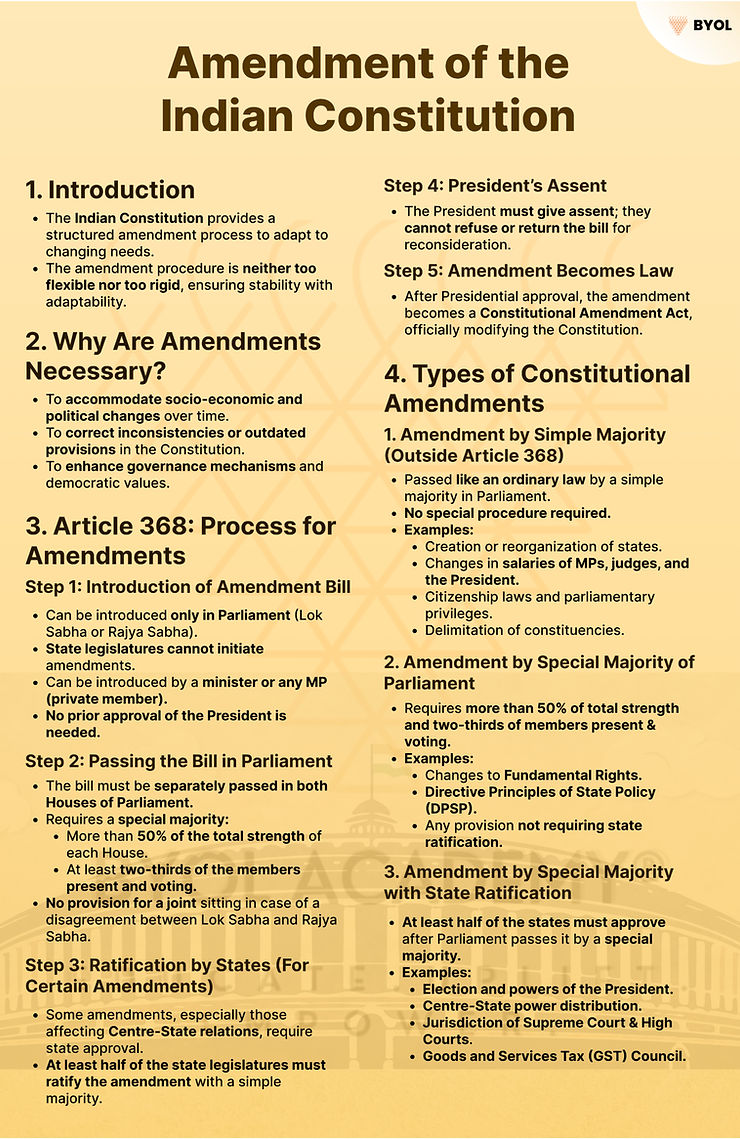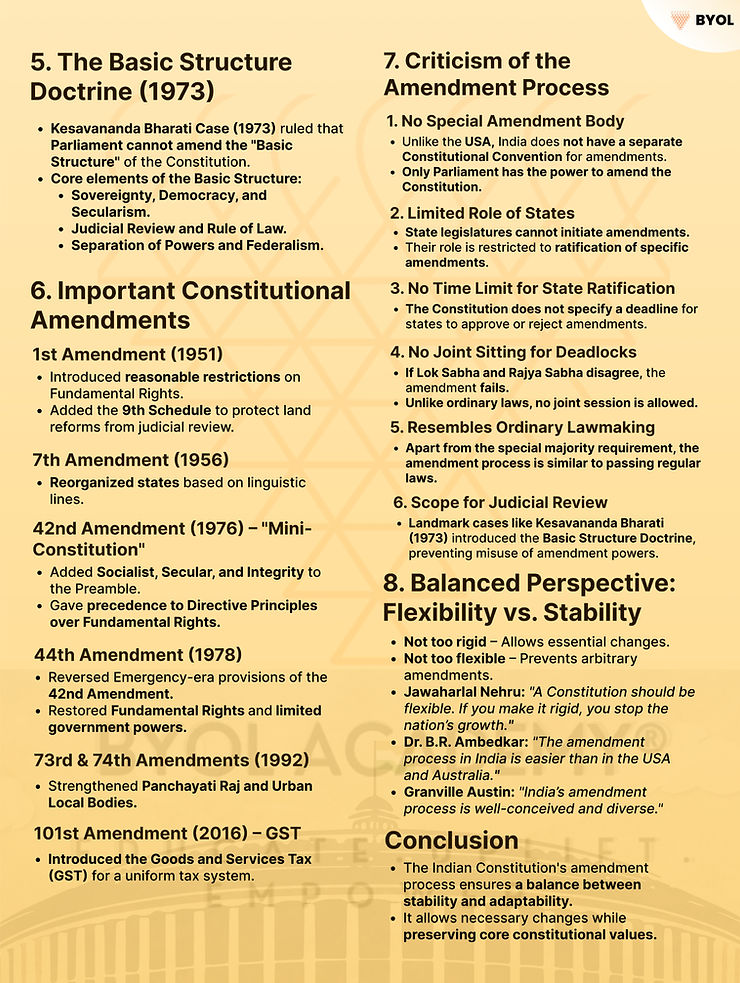Introduction
The Constitution of India provides for its amendment to adapt to changing needs and conditions. However, the amendment procedure is neither as flexible as in the UK nor as rigid as in the USA. It is a unique blend of both.
The Need for Amendments
The Indian Constitution must change to reflect shifting political, social, and economic circumstances, just like any other living text. The Constitution offers stability, but it also permits flexibility to accommodate future changes as needed.
Article 368: Process for Amendments
- Parliament has the authority to change the Constitution under Article 368 (Part XX).
- Amendments can be made through addition, variation, or repeal of any provision as per the prescribed procedure.
Doctrine of Basic Structure
- The Supreme Court ruled in the 1973 Kesavananda Bharati Case that the “Basic Structure” of the Constitution cannot be changed by Parliament.
- This theory guarantees the preservation of core values such as democracy, federalism, secularism, and judicial scrutiny.
Procedure for Amending the Indian Constitution
The Indian Constitution provides a clear and structured method for making changes while ensuring its fundamental principles remain intact. The amendment process, outlined in Article 368, ensures that necessary modifications can be made without undermining the Constitution’s core values.
1. Initiating the Amendment
- An amendment can only be introduced in Parliament, meaning state legislatures do not have the power to initiate constitutional changes.
- The bill can be introduced in either the Lok Sabha or the Rajya Sabha.
- It can be proposed by a minister or any MP (private member).
- Unlike some bills, prior approval from the President is not required.
2. Passing the Bill in Parliament
- Once introduced, the bill must be passed separately by both Houses (Lok Sabha and Rajya Sabha).
- The amendment requires a special majority, meaning:
- More than 50% of the total strength of each House must approve it.
- At least two-thirds of the members present and voting must support it.
- If there is a disagreement between the two Houses, a joint sitting is not allowed (unlike ordinary legislation).
3. Approval by States (For Certain Amendments)
- Some amendments, particularly those affecting Centre-State relations, require approval from the states.
- At least half of the state legislatures must ratify the amendment.
- State assemblies pass the bill with a simple majority (more than 50% of the members present and voting).
4. President’s Role
- After clearing Parliament and, if needed, the states, the bill is sent to the President for approval.
- Unlike ordinary bills, the President cannot refuse or return a constitutional amendment for reconsideration.
5. Becoming a Law
- Once the President gives formal approval, the bill becomes a Constitutional Amendment Act.
- The Constitution is officially modified in line with the changes introduced.
This process ensures that amendments are thoroughly debated and carefully considered, allowing the Constitution to evolve while preserving its fundamental structure.
Types of Constitutional Amendments in India
The Indian Constitution provides for three distinct methods of amendment, depending on the nature of the provisions being modified. These methods ensure that while necessary changes can be made, the core principles of the Constitution remain protected.
1. Amendment by Simple Majority of Parliament
Certain provisions of the Constitution can be amended through a simple majority, meaning more than 50% of the members present and voting in both Houses of Parliament. These amendments do not fall under Article 368 and follow the ordinary legislative process.
Provisions Amended by Simple Majority
- Creation or reorganization of states, including changes to their boundaries and names.
- Abolition or establishment of legislative councils in states.
- Salaries, allowances, and privileges of the President, Governors, MPs, judges, etc.
- Quorum requirements and procedural rules in Parliament.
- Citizenship-related provisions, including acquisition and termination.
- Delimitation of constituencies and election-related matters.
- Administration of Scheduled Areas and Tribes (Fifth and Sixth Schedules).
These amendments are treated as regular legislation and do not require a special process.
2. Amendment by Special Majority of Parliament
Most provisions of the Constitution require a special majority for amendment. This means the bill must be approved by:
- A majority of the total membership of each House, and
- At least two-thirds of the members present and voting.
This method ensures that fundamental changes are made with broad consensus.
Provisions Amended by Special Majority
- Fundamental Rights, which protect individual freedoms.
- Directive Principles of State Policy, which guide governance.
- Any other provision not covered under the first and third categories.
This process ensures that crucial elements of the Constitution are not altered without substantial parliamentary support.
3. Amendment by Special Majority with State Ratification
Some provisions, particularly those affecting Centre-State relations, require additional approval from the states. After being passed by Parliament with a special majority, these amendments must also be ratified by at least half of the state legislatures, with a simple majority in each.
Provisions Requiring State Ratification
- Election and manner of electing the President.
- Extent of executive powers of the Union and states.
- Powers and jurisdiction of the Supreme Court and High Courts.
- Distribution of legislative powers between the Centre and states.
- Structure and functioning of the Goods and Services Tax (GST) Council.
- Changes to any list in the Seventh Schedule (Union, State, and Concurrent Lists).
- Representation of states in Parliament.
- Amendment procedure itself (Article 368).
There is no fixed time limit for states to ratify the amendment, but once half of them approve, it is considered valid.
The Indian Constitution’s amendment process balances flexibility and stability. While it allows necessary changes, it also ensures that the fundamental framework remains intact. This structure helps the Constitution evolve while preserving its democratic and federal character.
Criticism of the Amendment Procedure
The Indian Constitution’s modification process has drawn a number of concerns. Although it aims to strike a balance between flexibility and rigidity, academics and legal experts have disagreed on some parts of the procedure.
1. Absence of a Special Amendment Body
India gives Parliament the only authority to modify the constitution, in contrast to the United States, which has a Constitutional Convention, and other nations with independent constitutional assemblies. No separate entity exists to deal solely with constitutional amendments.
2. States’ Role in Proposing Amendments Is Limited
While state legislatures in the USA are also able to propose constitutional changes, only Parliament in India has the authority to start reforms. In India, the sole exception is if a state legislature passes a resolution asking for the establishment or dissolution of its legislative council. Parliament has the last word and is not required to take any action, even in this situation.
3. Amendments Are Primarily Under Parliamentary Control
Parliament alone has the authority to modify a significant section of the Constitution with a simple or extraordinary majority. In contrast to the USA, where constitutional amendments required the consent of three-fourths of the states, only a small number of clauses need state ratification, and even then, only half of the states must agree.
4. No State Ratification Time Frame
There is no deadline set by the Constitution for state legislatures to accept or reject amendments. There is also no clarity on whether a state can withdraw its approval once granted.
5. No Joint Sitting for Deadlocks
- In case of a disagreement between the Lok Sabha and Rajya Sabha over a constitutional amendment bill, there is no provision for a joint sitting to resolve the deadlock.
- However, for ordinary legislation, a joint session can be held.
6. Amendment Process Resembles Ordinary Lawmaking
- Apart from the requirement of a special majority, there is little procedural difference between amending the Constitution and passing an ordinary law.
- This has raised concerns that constitutional changes could be made with relative ease.
7. Amendment Procedure is Brief and Leaves Scope for Judicial Interpretation
- The constitutional provisions regarding amendment are not detailed, leaving room for judicial intervention and interpretation.
- Courts have often had to step in to define the scope and limits of amendments, leading to landmark rulings like the Kesavananda Bharati case (1973), which introduced the Basic Structure Doctrine.
Balanced Perspective
Despite these criticisms, the amendment procedure has generally functioned effectively and allowed the Constitution to evolve with changing needs.
- It is not overly flexible, ensuring that amendments are not made arbitrarily by ruling parties.
- At the same time, it is not excessively rigid, allowing necessary modifications over time.
- Scholars like K.C. Wheare have praised the variety of amendment procedures in the Indian Constitution, calling it a wise approach rarely found elsewhere.
Views of Prominent Leaders
- Jawaharlal Nehru emphasized the need for flexibility, stating: “There should be a certain flexibility. If you make any Constitution rigid and permanent, you stop the nation’s growth.”
- Dr. B.R. Ambedkar appreciated the facile procedure for amendment, highlighting that India did not make amendments too difficult, unlike the USA or Australia.
- Granville Austin, a constitutional expert, noted that India’s amendment process, though appearing complicated, is actually well-designed and diverse.
While the amendment process has some limitations, it has generally served its purpose well. It maintains stability while allowing for necessary reforms, ensuring that the Constitution adapts to changing times without losing its fundamental character.






